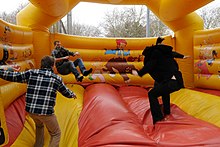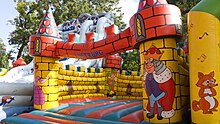Bouncy castle

A bouncy castle , spring castle or air castle is a structure made of airtight fabric that can be inflated with the help of a radial fan. There are many different shapes, colors and sizes.
You can usually find inflatables at parties or events. There are now entire bouncy castle parks where children can let off steam.
history
The bouncy castle was invented as an air castle in 1977 by the Austrian entrepreneur Elisabeth Kolarik (* 1954), the youngest daughter of the restaurateur Karl Kolarik (1901–1993), who founded the Schweizerhaus in Vienna's Prater, the largest beer garden in Europe .
In 1977 Elisabeth Kolarik wanted to create an inflatable playground for her daughter Marianne in the children's room. She had her design made from hot air balloon fabric by an English manufacturer. However, he mistakenly understood the measurements as inches instead of centimeters; this made the playground 2.54 times too big and could only be used outdoors. Elisabeth Kolarik took up the idea and subsequently designed numerous other models of air castles, which she rents out or sells. In 1992 she founded the “Luftburg” café-restaurant in the Prater, which is equipped with several of these playgrounds.
The inventor did not have the inflatable playground protected as a patent. However, the name Luftburg is protected by trademark law, so that competing products are usually referred to as a bouncy castle .
Instructions for use
Bouncy castles are usually entered barefoot or with socks, as pointed parts of shoes could damage the fabric. This also prevents soiling and thus extends the life of a bouncy castle (see porosity )
Due to the rubber cavity architecture, the structures can easily be 10 × 10 × 10 meters in size when inflated. In the idle state, however, they are easy to transport in the trunk of a station wagon or similar.
Since simple seams are used to join the pieces, air is constantly escaping from a bouncy castle. This would quickly make the castle limp again. Therefore, sufficient air is supplied during operation and the bouncy castle is kept in shape.
construction
Ideally, you should put a tarpaulin under the castle for protection. Now the fan is connected, which inflates the castle. Since bouncy castles are relatively light, lawns are hardly affected if they stand for less than a day and can recover well.
Inflatable castles are prone to wind because of their size and light weight. Therefore they should be secured with pegs and ropes before use.
advantages
- Children have fun, are active and have the opportunity to let off steam.
- Bouncy castles are usually also suitable as advertising media, as they attract families with children to various events with their bright colors.
- A supervised bouncy castle offers hours of fun.
- In contrast to carousels or other devices, bouncy castles can be operated, set up and picked up independently.
disadvantage
- Due to the blower, electricity is required for the entire operating time of the castle.
- There is danger if children collide in the castle or are thrown out of the castle.
- You should also react quickly if the fan fails, as the castle collapses quickly and children may be buried under it (danger of suffocation).
The castle must be supervised throughout the entire operating time. A judgment was issued by the Cologne Regional Court on this.
“The parents of a child who was thrown out of a bouncy castle at a parish festival and lost several teeth when it fell hard on the asphalt, sued the organizers for damages and compensation for pain and suffering. The LG Cologne awarded the plaintiff 40,000 euros because the bouncy castle was not continuously supervised and so the operator did not comply with his duty of safety . "
technology
Inflatable castles are technically related to air domes .
The material used can be flame retardant, coated PVC polyester fabric. The seams consist of double-stitched (fourfold in heavily used areas, in some cases particularly reinforced), abrasion-resistant and rot-resistant polyester or nylon thread.
In Germany there is the CE mark as well as the GS seal, which among other things certifies compliance with the safety regulations for toys and devices outdoors. However, these seals only apply to privately used inflatables. In the case of commercially operated castles, each castle must be individually approved by the TÜV (or in the case of castles made abroad by the respective national TÜV-like organization).
When it comes to quality, manufacturers also refer to the Inflatable Play Manufacturers Association and the ETIS 7 standard from the British Health and Safety Executive . The Etis 7 standard was withdrawn and since then there have been tests and seals of the Inflatable Play Association.
variants
- Climbing mountains - fall-proof due to the air cushioning
- Rodeo machines - fall protection
- Slide - e.g. B. Titanic slide
- Giant football
- movable bouncy castles - moving slides
- Bungee run
rental fee
End customers, i.e. party organizers, usually rent inflatables on a daily basis for the duration of an event. A standard bouncy castle (approx. 4 × 4 m) costs around 300 to 500 euros per day including assembly and supervision.
Purchase and custom order
The purchase price for a standard bouncy castle is around 2,000 to 5,000 euros. The later costs for storage, care and maintenance must also be taken into account. Larger companies that are active in sponsoring or that include marketing activities or sales promotion campaigns have individual bouncy castles and inflatables made that are designed in the corporate colors or whose shape emulates products.
Web links
Individual evidence
- ^ Mathias Ziegler: The unknown mother of the Luftburg: Elisabeth Kolarik in Wiener Zeitung of April 14, 2007, accessed on November 25, 2012
- ^ Family Kolarik ( Memento of the original from May 30, 2011 in the Internet Archive ) Info: The archive link was inserted automatically and has not yet been checked. Please check the original and archive link according to the instructions and then remove this notice. at www.kolarik.at, accessed on July 19, 2010


